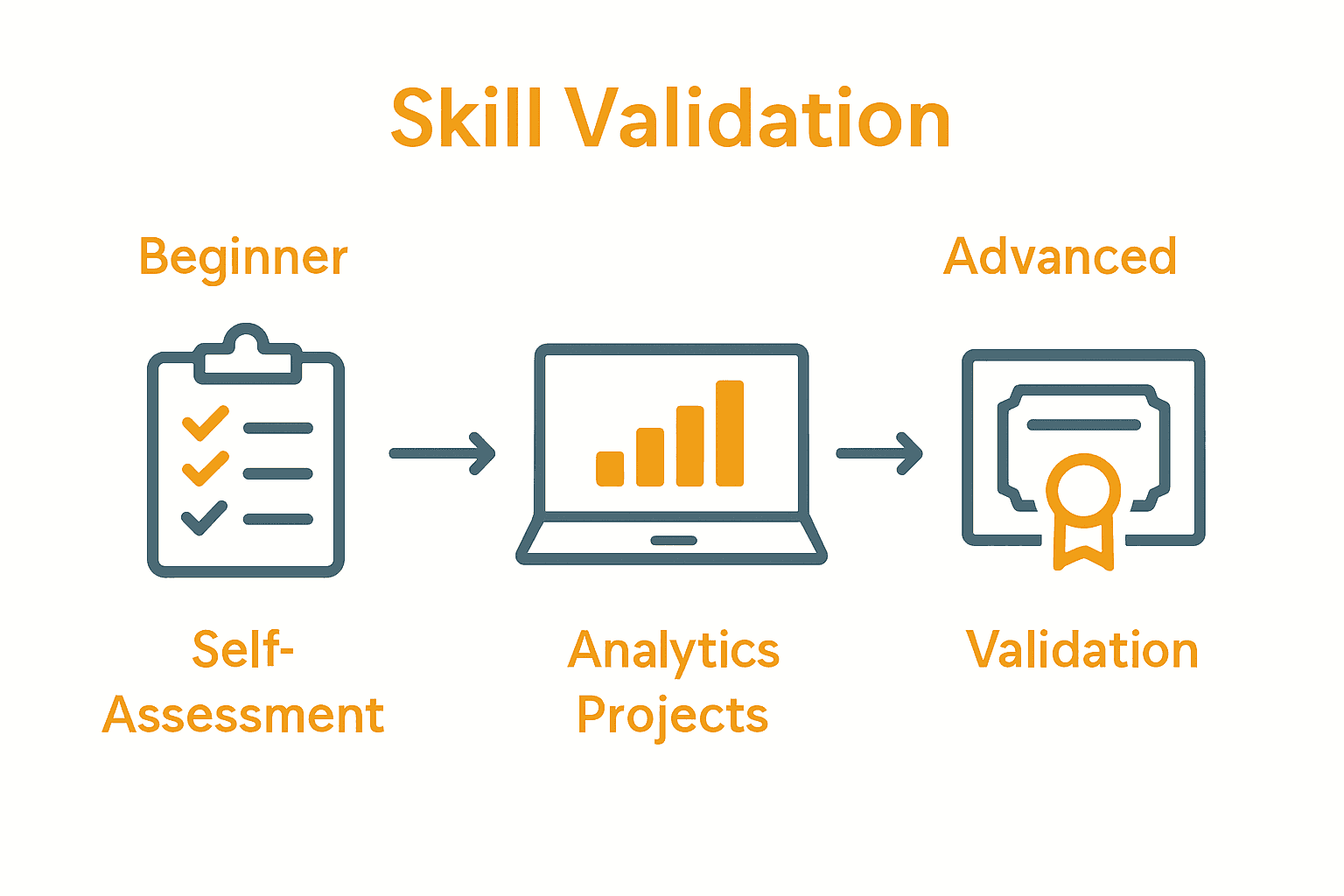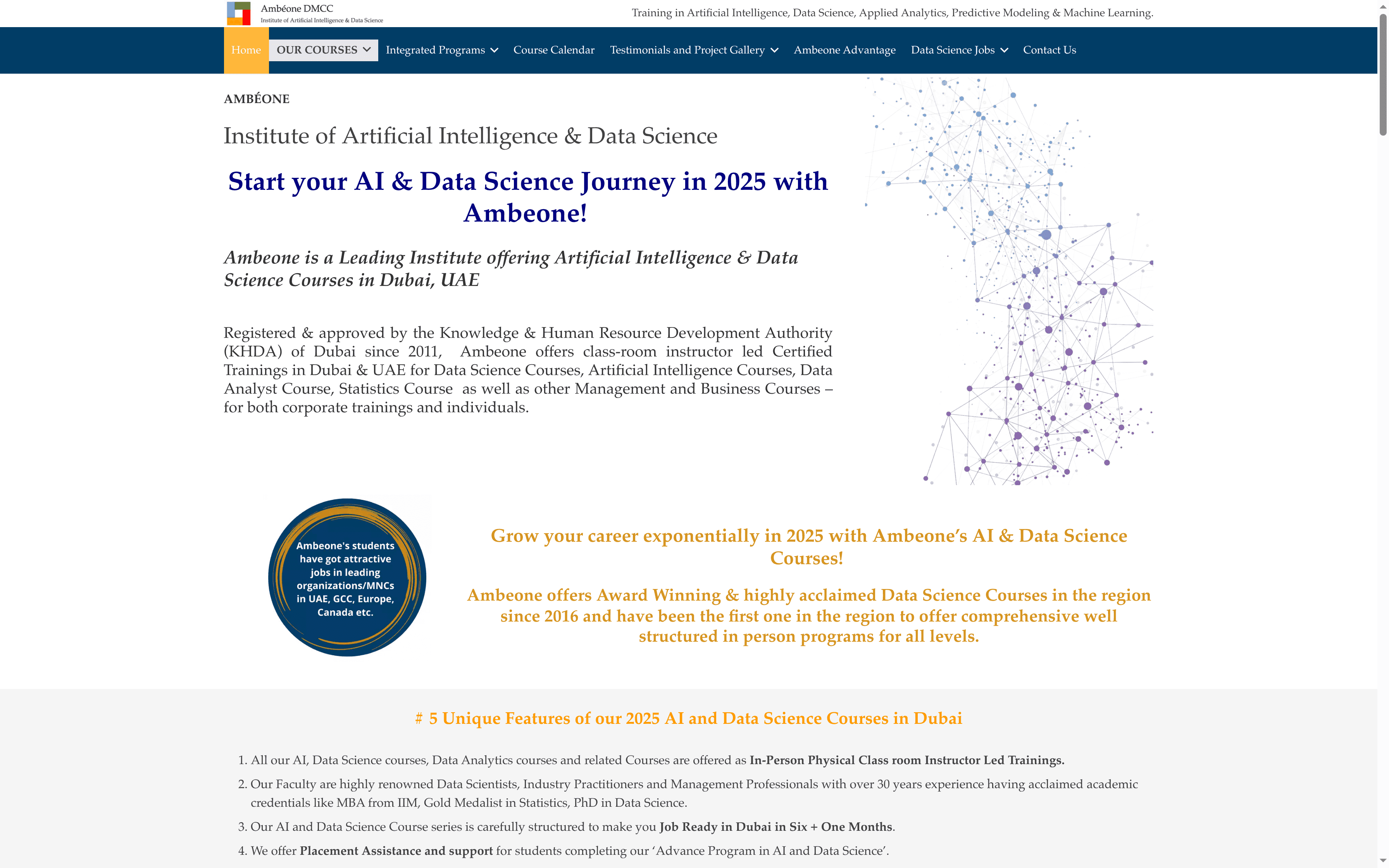Applied Analytics Training Guide for Career Advancement
Over 80 percent of analytics professionals say that targeted skills development is the foundation of career growth. In a fast-changing field where technology and business needs constantly shift, knowing what to learn and how to prove your expertise matters more than ever. Whether you are aiming to land your first analytics role or hoping to move up, this step-by-step guide provides a smart, practical framework to help you assess your skills, find the best training, and build real-world experience.
Table of Contents
- Step 1: Assess Current Analytics Skills And Set Clear Learning Goals
- Step 2: Select The Right Training Program Aligned With Business Needs
- Step 3: Engage In Hands-On Learning With Real-World Analytics Projects
- Step 4: Apply Analytics Tools To Solve Practical Business Problems
- Step 5: Validate Skills Through Certification And Performance Testing
Quick Summary
| Key Point | Explanation |
|---|---|
| 1. Assess your analytics skills | Conduct a self-assessment of your current skills across key analytics domains to identify strengths and weaknesses. |
| 2. Set clear learning objectives | Define specific, measurable goals for improvement that align with your career aspirations in analytics. |
| 3. Choose relevant training programs | Select training that aligns with both your learning goals and the strategic needs of your organization. |
| 4. Engage in hands-on projects | Work on real-world data projects to apply theoretical knowledge and develop practical analytical skills. |
| 5. Validate skills with certifications | Obtain industry-recognized certifications that demonstrate your practical capabilities in analytics effectively. |
Step 1: Assess current analytics skills and set clear learning goals
Successfully advancing your analytics career starts with a strategic self assessment of your current skills and defining precise learning objectives. According to research from slejournal, understanding your existing capabilities and setting targeted goals significantly enhances learning outcomes.
Begin by conducting a comprehensive skills inventory across key analytics domains. Create a detailed spreadsheet or document where you honestly rate your proficiency in areas like statistical analysis, programming languages (Python/R), data visualization, machine learning concepts, and database management. Be ruthlessly objective not just confident. Research from ceur-ws emphasizes the importance of guided goal setting to improve performance and engagement.
For maximum effectiveness, break down your skill assessment into specific measurable levels: beginner, intermediate, and advanced. Identify gaps between your current capabilities and the skills required for your target analytics role or career progression. This targeted approach allows you to design a personalized learning roadmap that addresses precise skill deficiencies. Types of Analytics Courses for Career Growth in UAE can provide additional insights into structured learning paths aligned with industry requirements.
Your next step involves translating this skills assessment into concrete learning goals.
 Select 2-3 key skill areas where you want significant improvement and create specific milestones. Instead of vague objectives like “get better at Python,” aim for precise targets such as “complete advanced data manipulation course and build two independent data analysis projects by quarter end.” This methodical approach transforms abstract aspirations into actionable professional development.
Select 2-3 key skill areas where you want significant improvement and create specific milestones. Instead of vague objectives like “get better at Python,” aim for precise targets such as “complete advanced data manipulation course and build two independent data analysis projects by quarter end.” This methodical approach transforms abstract aspirations into actionable professional development.

Step 2: Select the right training program aligned with business needs
Choosing the right analytics training program requires a strategic approach that connects your learning objectives with broader organizational needs. Research from link provides a comprehensive maturity framework highlighting key organizational facets such as data management, leadership support, technological infrastructure, and skill development.
Start by conducting a thorough organizational skills gap analysis. Map the current capabilities of your team against the strategic requirements of your business. According to francis-press, training programs must be precisely tailored to support specific strategic goals. Engage with department heads and leadership to understand emerging skill requirements, technological shifts, and performance expectations.
Evaluate potential training programs through a multifaceted lens. Consider factors like curriculum depth, instructor expertise, practical project opportunities, and alignment with industry certifications. Business Acumen Training can provide additional context for integrating technical skills with strategic business understanding. Prioritize programs offering hands-on experience, real world case studies, and opportunities to work with current industry tools and technologies.
Your selection process should also factor in scalability and adaptability. Look for training programs that offer flexible learning formats modular course structures and opportunities for continuous skill updates. The goal is not just acquiring knowledge but developing a sustainable learning pathway that evolves with your organization’s changing technological and strategic landscape.
Step 3: Engage in hands-on learning with real-world analytics projects
Transforming theoretical knowledge into practical expertise requires immersive hands-on learning experiences that mirror actual business challenges. According to research from journalofbigdata, hands-on projects are critical for predicting and enhancing learning outcomes in analytics and data science.
Begin by seeking out or creating comprehensive project scenarios that simulate authentic business problems. This means finding datasets from real industry contexts or participating in competitions that challenge you to solve complex analytical questions. Ambeone’s Nine Step Guide for Statistical Robust Data Science Projects can provide a structured approach to developing meaningful analytical projects. Research from telrp emphasizes the importance of self-directed learning environments that provide rich data contexts for skill development.
When selecting or designing projects, focus on diversity and complexity. Choose initiatives that require multiple analytical techniques such as predictive modeling, data cleaning, visualization, and statistical inference. Document your entire workflow including data preprocessing, model selection, validation strategies, and interpretation of results. This comprehensive approach transforms each project from a simple exercise into a portfolio worthy demonstration of your evolving analytical capabilities.
Remember that real world projects are about more than technical execution. They are opportunities to develop critical thinking skills, learn to communicate complex findings, and understand the broader business context of your analytical work. Each project should tell a story beyond numbers highlighting your ability to derive meaningful insights that drive strategic decision making.
Step 4: Apply analytics tools to solve practical business problems
Mastering analytics tools requires more than technical proficiency. It demands a strategic approach to transforming raw data into actionable business insights. Research from arxiv highlights the importance of a goal-based framework for selecting appropriate visualization techniques that effectively interpret complex data challenges.
Begin by identifying specific business problems that require analytical solutions. Business Analytics Using Data Science Machine Learning can provide context for understanding how analytical tools map onto real world scenarios. Develop a systematic approach to tool selection by assessing the complexity of your data, the specific business question you are addressing, and the required analytical depth. According to research from jime, analytics tools are most effective when they are precisely matched to the performance monitoring and problem solving objectives.
Implement a structured workflow that moves beyond technical execution. Start by cleaning and preprocessing your data, selecting appropriate analytical techniques whether descriptive, predictive, or prescriptive. Document each step of your analysis including data sources, transformation methods, model selection, and interpretation strategies. Your goal is to create a repeatable process that demonstrates not just technical skill but strategic analytical thinking.
Remember that powerful analytics is about storytelling. Each tool and technique should help you construct a narrative that translates complex data into clear, compelling business recommendations. The most successful analysts do not just crunch numbers they provide insights that drive meaningful organizational decision making.
Step 5: Validate skills through certification and performance testing
Validating your analytics skills goes beyond theoretical knowledge demonstrating practical competence through recognized certifications and rigorous performance assessments. Research from pmc underscores the critical role of performance testing in ensuring learners meet required professional competencies.
Begin by identifying industry recognized certifications that align with your specific analytics career goals. What Is Data Analytics? Complete Guide Explained can provide context for understanding the landscape of professional credentials. Look for certifications from reputable organizations that require practical skills demonstration rather than purely theoretical examinations. Consider credentials such as Certified Analytics Professional (CAP), Google Data Analytics Professional Certificate, or Microsoft Certified Data Analyst Associate that combine theoretical knowledge with practical skill validation.
Prepare for certification exams through a comprehensive strategy that includes structured study, practice projects, and simulated testing environments. Create a systematic preparation plan that involves mock assessments, detailed review of exam syllabi, and practical skill demonstrations. Focus not just on passing the exam but on truly understanding the underlying analytical principles and techniques. Your goal is to transform certification from a mere credential into tangible proof of your professional capabilities.
Remember that performance testing is an ongoing journey. Certifications represent snapshots of your skills at a particular moment continually seek opportunities to update your knowledge, participate in practical challenges, and demonstrate your evolving analytical expertise through real world projects and continuous learning.
Elevate Your Analytics Career with Tailored Training at Ambeone
The challenge of bridging the gap between current skills and advanced analytics expertise is real. This guide highlights the need for clear skill assessment, practical project experience, and recognized certification to excel in applied analytics. If you have felt stuck or unsure about which learning path to take, you are not alone. Many professionals struggle with selecting training programs that align with both personal growth goals and business needs. At Ambeone, we understand these pain points and offer structured, instructor-led courses designed to address them directly.

Transform your learning ambitions into actionable progress. Explore our Uncategorized Archives – Ambeone to discover courses that provide hands-on experience, strategic tool application, and performance validation. Our expert faculty and KHDA-approved programs ensure you gain not just knowledge but industry-relevant skills that boost career advancement. Don’t wait to build a future-proof analytics career. Visit Ambeone’s homepage now to take the first step toward mastering applied analytics with confidence.
Frequently Asked Questions
How can I assess my current analytics skills effectively?
To assess your current analytics skills, create a comprehensive skills inventory that rates your proficiency in areas like statistical analysis and programming. Use a detailed spreadsheet to honestly categorize your skills as beginner, intermediate, or advanced to identify gaps for targeted improvement.
What should I consider when selecting an analytics training program?
When selecting an analytics training program, evaluate factors like curriculum depth, instructor expertise, and practical project opportunities. Prioritize programs that offer hands-on experiences and real-world case studies to align with your learning objectives and organizational needs.
How can I engage in hands-on learning for analytics?
To engage in hands-on learning, seek out real-world analytics projects or simulations that reflect authentic business challenges. Create or join competitions that require solving complex analytical questions using actual datasets to build practical expertise.
What steps should I take to apply analytics tools to business problems?
To apply analytics tools effectively, start by identifying specific business problems requiring analytical solutions and develop a systematic approach to tool selection. Focus on the complexity of your data and the business question at hand, ensuring your analysis is clear and actionable.
How can I validate my analytics skills through certification?
You can validate your analytics skills by pursuing recognized industry certifications that require the demonstration of practical skills. Prepare systematically for certification exams by engaging in study projects and mock assessments to ensure a comprehensive understanding of analytical principles.
Recommended
- What Is Data Analytics? Complete Guide Explained – Ambeone
- The Essential Guide to Why Study Data Analytics – Ambeone
- 7 Types of Analytics Courses for Career Growth in UAE – Ambeone
- 7 Key Data Analytics Job Roles Every Professional Should Know – Ambeone
- How to Choose Analytics Tools: Guide for Marketers 2025
- Importancia del análisis de datos para empresas y su comprensión | Itcons.app

